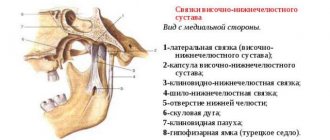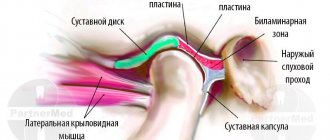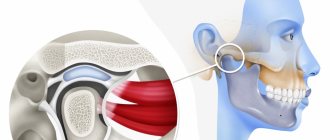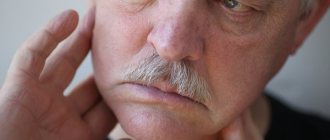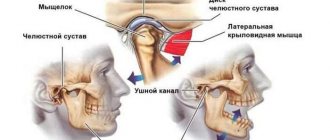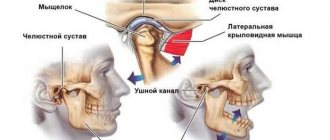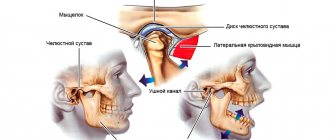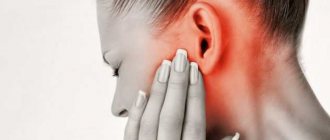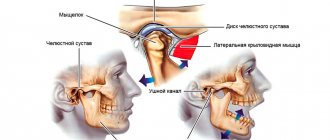The clinic of orthodontics, gnathology, and aesthetic dentistry MY ORT offers treatment for arthritis of the temporomandibular joint. This disease is rare, but requires timely attention from a specialist to avoid serious complications.
Arthritis of the TMJ, depending on the causes, is divided into three types:
- The infectious form is a consequence of a previous disease or inflammatory process. The main causes are previous tuberculosis, syphilis, gonorrhea, diseases of a rheumatological nature.
- The dystrophic form appears with constant heavy loads on the joint area. Such regular exposure causes tissue changes and causes illness.
- Traumatic arthritis develops against the background of a severe bruise or injury. The danger of this form is that the Patient does not immediately understand the development of the problem. After a bruise, pain and swelling are observed. But it is precisely these symptoms that indicate the development of damage to the joint area, which many patients mistakenly do not pay attention to.
According to the method of infection penetration into the blood, arthritis is divided into hematogenous, contact, and direct. In hematogenous infection, pathogenic bacteria enter the body through the blood. In the second method, the source of infection becomes inflammatory processes in the lower jaw, middle ear or salivary gland. With timely treatment, complications rarely develop. But with a chronic form or lack of therapy, there is a high risk of developing arthritis. The direct method involves injuries or complications that develop after surgical operations.
Characteristics of the disease
In medicine, the disease is called arthritis of the temporomandibular joint (TMJ). With the help of this joint all movements of the lower jaw occur.
The inflammatory process can occur in acute or chronic form. The main sign of the development of pathology is restriction in the movement of the lower jaw.
Such a pathology requires complex treatment and intervention by specialists of various profiles.
Depending on the area of localization, there are several forms of arthritis:
- disease of the lower or upper joint;
- arthrosis of the upper jaw joint.
Osteoarthritis occurs when a joint is severely deformed. The lesion affects both areas of the jaw node, the cartilage tissue is destroyed. In the first stages, the joint capsule becomes inflamed, then the cartilage tissue is affected.
So, due to education, they distinguish:
- infectious arthritis of the TMJ - is caused by infections and bacteria entering the bloodstream, which stimulate the inflammatory process of the joint. In turn, an infectious disease may be of a rheumatological nature or be a consequence of the presence or transmission of diseases such as tuberculosis, syphilis, gonorrhea, etc.;
- dystrophic arthritis of the TMJ - develops as a result of constant heavy physical labor;
- traumatic arthritis of the TMJ - is a consequence of a severe bruise or injury.
Risk factors
Main reasons:
- Injury. The cause in this case may be a bruise, a blow, or a sudden opening of the mouth.
- Infection of ENT organs. Arthritis of the maxillary joint can be caused by streptococci, chlamydia or tuberculosis.
- Osteomyelitis.
- Untreated caries.
- Periodontal diseases.
- Otitis.
In addition, the following conditions may also affect the development of jaw arthritis:
- Gout.
- Systemic lupus erythematosus.
- Diabetes.
- Thyroid diseases.
- Rheumatoid and reactive arthritis.
Sometimes inflammation can be caused by general hypothermia of the body.
Treatment of TMJ arthritis
When TMJ arthritis is diagnosed, treatment involves constant rest for the patient.
The acute course of the disease is treated according to the following algorithm:
- immobilization of the affected joint (for this, an unloading belt or intermaxillary ligature is used);
- then the doctor selects and prescribes a course of antibiotics, taking into account the characteristics of the infection that provoked the disease and the patient’s individual sensitivity to medications;
- To reduce and subsequently eliminate the inflammatory process, non-steroidal medications are prescribed;
- drugs are prescribed that can suppress the effect of free histamine;
- the patient’s state of mental peace is maintained by sedatives;
- to achieve maximum effect, a course of physiotherapy is prescribed: novocaine electrophoresis, laser therapy;
- Compresses with demixide are regularly applied to the affected side;
- if there is an admixture of pus in the joint, then aspiration is indicated.
Subacute stage of the disease (begins after 14-21 days) and is treated with the following method:
- restoration of damaged joint tissues and prevention of scarring;
- prescribing medications that increase microcirculation;
- a complex of vitamins to boost and maintain immunity;
- biogenic stimulation;
- enzyme therapy.
How does the disease manifest itself?
- pain in the jaw area, radiating to other parts of the face and intensifying when opening the mouth;
- restrictions in joint movement;
- dizziness, chills;
- general weakness;
- increased body temperature (may be over 38 degrees);
- sleep problems;
- jaw clicks;
- joint pain on palpation;
- deformation of the oval of the face due to the fact that the chin begins to move to the side;
- hearing problems.
The important thing is that with arthritis of the jaw joint, purulent inflammation can begin! In such a situation, the joint turns red, swells and becomes very sensitive. A compaction is felt in the area of the mandibular joint. The skin changes its color, speech is impaired, and the process of chewing food becomes difficult.
Diagnosis of TMJ arthritis
Taking into account the etiology of the disease and based on the main reason for its occurrence, in order to establish the most accurate diagnosis necessary for selecting high-quality and qualified treatment, the leading specialist can prescribe a consultation and examination by doctors of narrow specialization in the field of dentistry, traumatology, rheumatology, otolaryngology, dermatology, phthisiology and Infectiology.
The main way to diagnose the disease is x-ray examination. Currently, in modern medicine, in order to avoid excessive radiation exposure, patients are prescribed computed tomography. If, based on X-rays or other imaging tests, it is determined that the patient has widening of the joint space, then he is diagnosed with acute arthritis of the TMJ, and narrowing of the joint space indicates the chronic nature of the disease.
If the patient has acute arthritis, then it must be differentiated from diseases such as:
- Triple neuralgia;
- acute otitis;
- pericoronitis.
Type of pathology
The clinical picture of arthritis depends on the form in which the disease occurs:
Acute form.
It is expressed by swelling of the soft tissues and severe pain in the affected area. As a rule, the acute form is the result of some kind of injury.
Chronic form.
This form is manifested by aching pain and difficulty opening the jaw, especially in the morning.
Infectious form.
Most often it is a consequence of a previous illness (flu, ARVI). Infectious arthritis is characterized by severe pain that makes it difficult to open the mouth. The pain radiates to the ears, temples and back of the head.
Traumatic appearance.
The most common form of the disease that occurs against the background of trauma.
Specific arthritis.
Rare disease. As a rule, it occurs as a consequence of syphilis, tuberculosis or gonorrhea.
Purulent form.
It is a consequence of acute arthritis in an advanced form. A compaction forms in the area of the mandibular joint, and body temperature may increase.
Rheumatoid form.
Constant pain in the maxillary joint area. With this form, the clinical picture may be supplemented by pain in the knee, hip or elbow joint.
Depending on what caused the inflammation, the following routes of infection are distinguished:
- Hematogenous. Bacteria enter the joint along with the blood (syphilis, tuberculosis, measles, etc.).
- Contact path. The disease develops due to damage to areas located near the maxillary joint (otitis, phlegmon, abscess).
- Straight way. Develops due to direct penetration (wound, jaw fracture).
The form of pathology can be identified only after examination and diagnostic testing.
Diagnosis and treatment methods
Inflammatory processes of the TMJ can be diagnosed in the early stages, but this requires timely treatment. Initially, the lesion is localized in the capsule, but as the problem progresses, it spreads to the surrounding tissues. If left untreated, joint mobility may be completely lost.
Diagnosis is made during the initial visit to the dentist. Additionally, consultations with a traumatologist, otolaryngologist, infectious disease specialist and other specialists may be required. The basic methods are CT, radiography, CBCT. Using an x-ray, the dentist is able to determine the presence of arthritis, widening or narrowing of the joint gap. The following types of examinations are also carried out:
- Schüller and Bordes techniques for lateral examination of the affected area;
- plain radiographs;
- layered tomography;
- zonography;
- contrast arthrography;
- magnetic resonance imaging;
- diagnostics ELISA (enzyme-linked immunosorbent assay);
- PCR study.
Treatment begins with analyzing the data obtained and drawing up a treatment regimen. The jaw is immobilized and the affected organ is kept at rest for 2-3 days. If necessary, a sling bandage, splint or interdental plate is applied. The patient should follow a semi-liquid diet, relieving tension on the joint. The treatment regimen depends on the form and degree of the lesion; physiotherapy and myogymnastics are usually prescribed.
In the acute form, injections of antibiotics, corticosteroids, and chondroprotectors are prescribed. In case of purulent form, surgical intervention, opening of the cavity, and drainage through an external incision are indicated. Chronic arthritis requires the use of physiotherapy methods, sanitation of the oral cavity and nasopharynx. In some cases, dental prosthetics are indicated.
Infectious inflammation
If the cause of arthritis in the jaw joint is the action of harmful organisms, the main focus of therapy is treatment of the provoking disease. Until it is clear which aggressor started the inflammatory process, the doctor prescribes antibacterial drugs with a wide range of influence. When the pathogen is identified, the medications are replaced by those that most effectively fight the specific disease.
Non-steroidal anti-inflammatory drugs are also included in therapy, whose task is to counter the spread of inflammation. They are often combined with antihistamine complexes to make the swelling go down faster.
If conservative treatment is ineffective (usually this happens in the later stages of the disease), surgical intervention is prescribed. The operation is performed under general anesthesia, the cavity is cleaned of pus and a drainage is installed to drain the secreted fluids from the tissues. Postoperative treatment consists of painkillers, anti-inflammatory and antibacterial drugs. If recovery proceeds without pathologies, physiotherapeutic procedures are prescribed 3-4 days after the surgeon’s work. Until the drainage is removed, the patient is prescribed a strict diet consisting exclusively of liquid food.
Manifestation of jaw arthritis
In this case, the disease causes a feeling of pressure on the jaw joint or both joints. Later it becomes impossible to fully open the mouth. As the disease further develops, the patient's body temperature can rise to 39 degrees. Often at this stage even intoxication occurs.
The affected joint or both joints become very painful and swollen. The mucous membrane around the joints becomes inflamed. Then the pain intensifies and begins to radiate to the ears and temples. Bursts of pain are felt even when walking or tilting the head.
Traumatic inflammation
The first thing that is required is to ensure the immobility of the affected joint. This should be done by a professional traumatologist. The patient's jaw is fixed with a sling-shaped bandage equipped with a special plate that prevents the jaws from closing. This allows the victim to eat food, even if only in liquid form. Cold compresses are recommended to prevent swelling; At the same time, the doctor will prescribe medications that prevent the development and spread of inflammatory processes. In most cases, systemic administration of painkillers is also required, since injuries are associated with a gross violation of tissue integrity, which can lead to painful shock.
After the swelling subsides, physical therapy will be added to the medicinal treatment methods, designed to prevent the affected joint from fusing into a fixed conglomerate. Physiotherapy is also used: UHF, electrophoresis, diadynamic therapy, phonophoresis with hydrocortisone.
Possible complications
If you ignore the symptoms of inflammation of the jaw joint and do not start treatment on time (or replace it with amateur actions), then there is a risk of developing severe complications.
If arthritis of the jaw is of infectious origin, the inflammation will not go away on its own . The pus that accumulates during the process can lead to the “melting” of the components of the joint - cartilage, capsule, ligaments. As a result, things can reach the point of complete immobilization of the joint.
With hematogenous and contact spread of microorganisms, a patient with jaw arthritis may develop meningitis . This is a very dangerous disease, manifested by severe headaches with a rise in body temperature to dangerous levels (400C and above), fainting and photophobia. Failure to take urgent and professional measures leads to the death of a person.
Phlegmon of the temporal region. This is the name for inflammation accompanied by pus formation. It occurs in soft tissues and requires immediate surgical intervention. The root cause of phlegmon may well be jaw arthritis, but without additional circumstances it alone does not lead to the disease. The development of phlegmon also requires a persistent, long-term weakening of the immune system, which is often found in older people.
Inflammation of the jaw joint, left without proper treatment, can also lead to sepsis - penetration of pyogenic bacteria into the circulatory system . Through it they are transported to all points of the human body. The consequence is a massive inflammatory process, manifested by weakness, pathologically excessive sweating, increased breathing and heart rate, and loss of consciousness. The most terrible outcome of the disease is septic shock, which in 50% of cases ends in the death of the patient.
Don't forget about ankylosis. Adhesions filling the articular cavity make the joint immobile; with a bilateral lesion, this results in the inability to open the mouth slightly; with a unilateral lesion, this results in a distortion of the face. The patient most likely will not die from hunger; surgeons and rheumatologists will be able to restore at least partial jaw mobility to the patient. But the treatment will be very long, painful and expensive. And the patient’s quality of life will become very low until the end of at least the first stage of treatment.
And finally, relapses. An incorrectly selected course of treatment, non-compliance with medical prescriptions, or insufficiently long therapy can relieve or smooth out symptoms. But the inflammatory focus remains, and inflammation of the jaw joint will soon begin with renewed vigor.
Diseases of any joints require early treatment. And its course should be prescribed by a professional who is able to correctly determine the cause of the disease, take into account its severity and the characteristics of the patient’s physiology (age, presence of concomitant diseases, resistance of the immune system, and much more).
Forecast and prevention of TMJ arthritis
If, upon detection of the first symptoms of the disease and timely contact with a specialist, the correct treatment is performed, the prognosis for recovery is favorable. This applies to any form of TMJ arthritis. If you neglect the symptoms and endure pain, then there is a risk of developing TMJ ankylosis.
The main preventive measure that will allow you to avoid the disease is the sanitation of the oral cavity, the implementation of regular hygiene procedures, as well as the treatment of infectious diseases under the close supervision of a doctor.
What symptoms should you see a doctor for?
The earlier the diagnosis is made, the more favorable the prognosis. So seek help if:
- you experience pain in the lower jaw - intense or mild;
- you cannot fully move your jaw, you feel limited;
- hear a painful clicking or crunching sound when opening and closing your mouth;
- pain and noise in the ears appeared (especially if the otolaryngologist did not find any pathologies);
- There was a feeling of incomplete bite.
Arthrosis of the TMJ is not a very common phenomenon, but quite dangerous. Our usual comfort during conversation, eating, and other household activities is at risk. To avoid this, do not attribute alarming symptoms to fatigue and do not rely on “it will go away on its own”: be sure to find time for yourself and your health!
Rheumatoid inflammation
This type of jaw arthritis is mostly treated by a rheumatologist, although further guidance may be needed from other doctors. Drug treatment is mainly limited to relieving inflammation and pain; Physiotherapeutic procedures act as a supporting and accelerating effect. But therapy is not limited to these areas only , since with rheumatoid arthritis there is a very high probability of developing ankylosis of the joint, which threatens partial (and sometimes complete) loss of its mobility. This phenomenon is explained by pathological growth of tissue in the articular cavity; there is no gap left for rotation of the joint parts. Therefore, a person with such a diagnosis must constantly work on the diseased joint. The exercises are simple, but require regular performance, at least three times a day, and only after pain has been eliminated and inflammation has been relieved.
Experts in physical therapy consider four exercises to be the most effective:
- the chin is pressed with the palm from below, the mouth slowly opens, overcoming resistance. With the same speed and the same pressure, the mouth closes;
- the chin is grasped with the fingers, the jaw rises and falls. Your hand should press in the “down-back” direction;
- fingers press on the side of the jaw; the chin moves left and right. Then pressure is applied from the opposite side, and the exercises are repeated;
- the chin is pushed back by the hand; The jaw should be pushed forward as much as possible.
Each exercise is repeated three times. When performing them, pain may begin; if they are strong, you should do fewer approaches per day, reduce the intensity of pressure, or even take a break for several days. If the pain does not go away, the supervising doctor should be notified about the condition of the jaw.
It is worth making one more clarification. Like other diseases, inflammation of the jaw joint can go from acute to chronic. In this case, after the onset of a period of remission, the main emphasis in treatment is on physical therapy. In addition to the already mentioned electrophoresis and UHF, mud therapy and paraffin therapy provide good therapeutic results.


